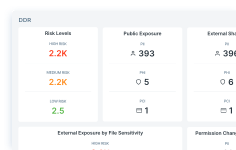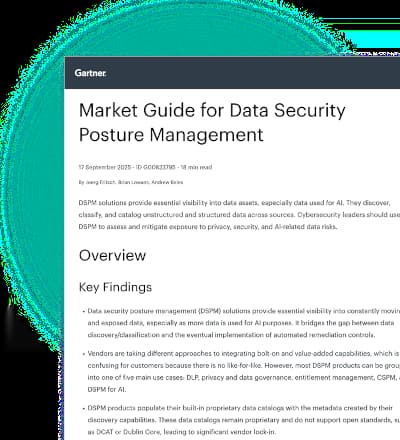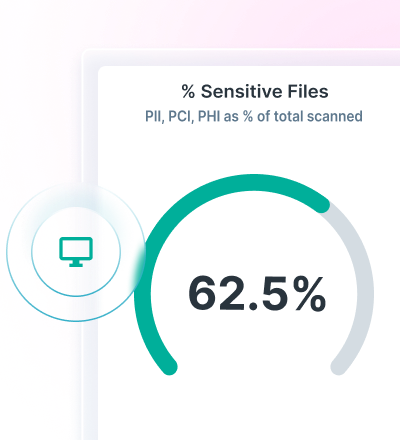How DSPM Helps You Identify and Prioritize Risky Data
0 min read

Tim Herr
Collecting, storing and processing massive amounts of data used to be specialized activities, but now they’re simply part of doing business at the enterprise level. And although most organizations are keen on reaping the benefits of data as an asset, many are still unprepared to deal with its manifold risks.
Understanding what makes data risky and how to mitigate these risks is crucial for maintaining a secure and compliant environment. This is where Forcepoint Data Security Posture Management (DSPM) comes into play, offering a proactive solution to identify and prioritize risky data.
What causes data to be risky?
Data can become risky for several reasons. Sensitive information, such as Personally Identifiable Information (PII), financial records and intellectual property, can be targeted by cybercriminals. Over-permissioned data, where users have access beyond their needs, increases the risk of accidental or malicious misuse. Additionally, data duplication and outdated information can clutter systems, making it harder to identify and protect critical assets.
Attacking risk with the Data Security Everywhere framework
Forcepoint's Data Security Everywhere framework provides a structured approach to managing data risks. This framework consists of five key steps:
- Discover: Locate all data across your organization
- Classify: Categorize data based on sensitivity and risk
- Prioritize: Focus on the most vulnerable data
- Remediate: Take corrective actions to secure data
- Protect: Ensure ongoing protection against data breaches
Identifying data with Forcepoint DSPM
Forcepoint DSPM excels in the discovery and classification of data, with the capability to scan vast amounts of data quickly and accurately. This ensures that sensitive information is identified and classified correctly, reducing the risk of exposure and helping organizations comply with regulations.
The discovery process involves scanning all data repositories, including on-premises systems, cloud storage and hybrid environments. This comprehensive approach ensures that no data is overlooked.
Once discovered, the data is classified based on predefined criteria, such as sensitivity, regulatory requirements and business value. This classification helps organizations understand the nature of their data and prioritize their security efforts accordingly. The DSPM solution’s classification activities are driven by the innovative AI Mesh engine, which allows it to improve its accuracy in relation to your unique data holdings.
Prioritizing data with Forcepoint DSPM
Prioritizing data is a critical aspect of risk management. Forcepoint DSPM provides detailed insights into the risk levels of different data sets, allowing organizations to focus their efforts on the most vulnerable areas. This prioritization helps in making informed decisions about where to invest in security measures and how to mitigate risks effectively.
Forcepoint DSPM uses a risk-based approach to prioritize data. This involves assessing the potential impact of data breaches, the likelihood of data being targeted and the current security posture of the data. By considering these factors, DSPM can generate a risk score for each data set, enabling organizations to focus on the highest-risk areas first. This targeted approach ensures that resources are allocated efficiently and that the most critical data is protected.
Get comprehensive coverage with Forcepoint Data Security Cloud
Forcepoint Data Security Cloud is a unified platform that integrates DSPM and Data Detection and Response (DDR) together with the award-winning Forcepoint Data Loss Prevention (DLP), Forcepoint Web Security and Forcepoint Cloud App Security. This integrated solution offers a holistic approach to data security, ensuring that organizations can identify, prioritize and protect their data effectively. By leveraging these tools, businesses can build a robust security strategy that addresses the full spectrum of data risks.
Forcepoint Data Security Cloud provides continuous monitoring and protection against data breaches and leaks. DDR enhances DSPM by detecting and responding to threats in real time, while DLP prevents data loss by enforcing security policies. Web Security and Cloud App Security complete the picture by protecting access to potentially risky websites and to cloud-based applications, including shadow IT. Together, these solutions create a comprehensive security framework that safeguards sensitive data and ensures compliance with regulatory requirements.
Forcepoint DSPM offers a powerful solution for identifying and prioritizing risky data, and it can be further enhanced by the complementary solutions included in Data Security Cloud. By implementing these tools, organizations can build a strong security posture and protect their most valuable assets.
Talk to an expert today to learn more about which Forcepoint data security solution(s) are best suited to your current needs and budget.

Tim Herr
Read more articles by Tim HerrTim serves as Brand Marketing Copywriter, executing the company's content strategy across a variety of formats and helping to communicate the benefits of Forcepoint solutions in clear, accessible language.
- The Forcepoint Data Security Cloud Platform
In the Article
 The Forcepoint Data Security Cloud PlatformLearn More
The Forcepoint Data Security Cloud PlatformLearn More
X-Labs
Get insight, analysis & news straight to your inbox

To the Point
Cybersecurity
A Podcast covering latest trends and topics in the world of cybersecurity
Listen Now









